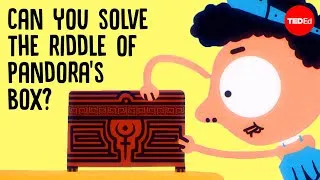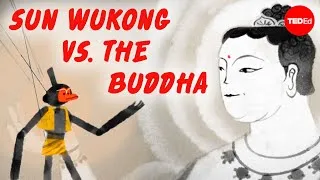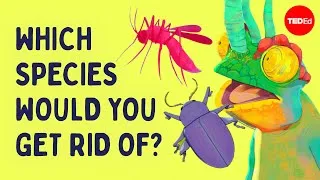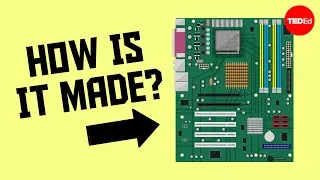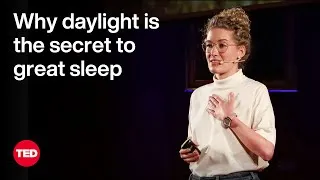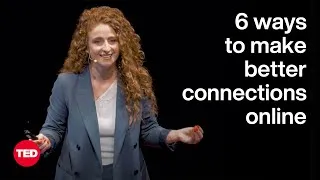請雙擊下方英文字幕播放視頻。
譯者: Bill Hsiung
審譯者: Katherine Liu
00:12
So, people argue vigorously about the definition of life.
0
12160
3000
人們一直在激烈地爭論著生命的定義。
00:15
They ask if it should have reproduction in it, or metabolism, or evolution.
1
15160
5000
他們詢問繁殖、代謝、演化,是否是所有生命共有的特徵。
00:20
And I don't know the answer to that, so I'm not going to tell you.
2
20160
2000
因為我不知道這個問題的答案,所以我不會給你們任何解答。
00:22
I will say that life involves computation.
3
22160
3000
我會說,生命跟計算有關。
00:25
So this is a computer program.
4
25160
2000
所以這是一個電腦程式。
00:27
Booted up in a cell, the program would execute,
5
27160
3000
待細胞開機後,這個程式會執行
00:30
and it could result in this person;
6
30160
3000
並產生了這個人
00:33
or with a small change, it could result in this person;
7
33160
3000
稍微做點變化,也許產生的是這個人 —
00:36
or another small change, this person;
8
36160
2000
再做點改變 — 變成了這個人,
00:38
or with a larger change, this dog,
9
38160
3000
做大一點的變化,變成這隻狗
00:41
or this tree, or this whale.
10
41160
2000
或者樹或者鯨魚。
00:43
So now, if you take this metaphor
11
43160
2000
如果你認真看待
00:45
[of] genome as program seriously,
12
45160
2000
基因體是程式這個比喻,
00:47
you have to consider that Chris Anderson
13
47160
2000
你會認為 Chris Anderson
00:49
is a computer-fabricated artifact, as is Jim Watson,
14
49160
3000
是一個電腦製成的物品,詹姆士•華生跟
00:52
Craig Venter, as are all of us.
15
52160
3000
克萊格•凡特也是,我們都是。
00:55
And in convincing yourself that this metaphor is true,
16
55160
2000
為了說服你自己這個比喻是真的,
00:57
there are lots of similarities between genetic programs
17
57160
2000
基因程式與電腦程式間極多的相似之處
00:59
and computer programs that could help to convince you.
18
59160
3000
也許能夠使你相信這是真的。
01:02
But one, to me, that's most compelling
19
62160
2000
但是對我來說最令人信服的
01:04
is the peculiar sensitivity to small changes
20
64160
3000
是他們都對於細微的改變極其敏感
01:07
that can make large changes in biological development -- the output.
21
67160
3000
這改變對於生物發展的結果可以非常的大。
01:10
A small mutation can take a two-wing fly
22
70160
2000
一個小突變可以讓本來只有一對翅膀的蒼蠅
01:12
and make it a four-wing fly.
23
72160
1000
生出兩對翅膀。
01:13
Or it could take a fly and put legs where its antennae should be.
24
73160
4000
或者它可以讓蒼蠅本來長觸角的地方生出腿來。
01:17
Or if you're familiar with "The Princess Bride,"
25
77160
2000
或者你對電影「公主新娘」比較熟悉,(或譯:綠野芳蹤)
01:19
it could create a six-fingered man.
26
79160
2000
它能夠使人生出六隻手指。
01:21
Now, a hallmark of computer programs
27
81160
2000
而電腦程式的特徵
01:23
is just this kind of sensitivity to small changes.
28
83160
3000
也不過就是這種對於細微改變的靈敏度。
01:26
If your bank account's one dollar, and you flip a single bit,
29
86160
2000
如果在你一塊錢的銀行帳號中就更動一個位元而已,
01:28
you could end up with a thousand dollars.
30
88160
2000
你就有了一千元。
01:30
So these small changes are things that I think
31
90160
3000
這些小變化使我認為
01:33
that -- they indicate to us that a complicated computation
32
93160
2000
— 它們告訴我們演化之中發生的複雜運算
01:35
in development is underlying these amplified, large changes.
33
95160
4000
都埋藏在這些被放大的差異中。
01:39
So now, all of this indicates that there are molecular programs underlying biology,
34
99160
6000
所有的這些都顯示著生物的裡層其實埋藏著分子程式,
01:45
and it shows the power of molecular programs -- biology does.
35
105160
4000
而生物現象其實就是這些分子程式威力的展現。
01:49
And what I want to do is write molecular programs,
36
109160
2000
而我想要做的事就是撰寫這些有潛力
01:51
potentially to build technology.
37
111160
2000
能用來建造科技的分子程式。
01:53
And there are a lot of people doing this,
38
113160
1000
現在有很多人在做這方面的研究,
01:54
a lot of synthetic biologists doing this, like Craig Venter.
39
114160
3000
很多合成生物學家正在做這些研究,如:克萊格•凡特
01:57
And they concentrate on using cells.
40
117160
2000
他們大多專注在利用細胞。
01:59
They're cell-oriented.
41
119160
2000
他們是細胞導向的。
02:01
So my friends, molecular programmers, and I
42
121160
2000
但是我的朋友們和我,我們這些分子程式設計師
02:03
have a sort of biomolecule-centric approach.
43
123160
2000
有著不同的生物分子中心途徑。
02:05
We're interested in using DNA, RNA and protein,
44
125160
3000
我們著迷於利用 DNA, RNA 和蛋白質
02:08
and building new languages for building things from the bottom up,
45
128160
3000
來建造能從基礎用來建造東西的新程式語言,
02:11
using biomolecules,
46
131160
1000
只是利用這些生物分子們,
02:12
potentially having nothing to do with biology.
47
132160
3000
可能跟生物一點關係都沒有。
02:15
So, these are all the machines in a cell.
48
135160
4000
這些都是細胞內的微機械。
02:19
There's a camera.
49
139160
2000
這是攝影機。
02:21
There's the solar panels of the cell,
50
141160
1000
這是細胞裡的太陽能板,
02:22
some switches that turn your genes on and off,
51
142160
2000
某些用來控制基因的開關,
02:24
the girders of the cell, motors that move your muscles.
52
144160
3000
細胞的樑柱,運動肌肉的馬達。
02:27
My little group of molecular programmers
53
147160
2000
我的分子程式設計小組
02:29
are trying to refashion all of these parts from DNA.
54
149160
4000
試圖利用 DNA 來重製這些零件。
02:33
We're not DNA zealots, but DNA is the cheapest,
55
153160
2000
我們不是 DNA 狂熱分子,但是 DNA 是最便宜,
02:35
easiest to understand and easy to program material to do this.
56
155160
3000
最容易了解,最容易用來設計程式的物質。
02:38
And as other things become easier to use --
57
158160
2000
如果當其他東西變得更容易使用 —
02:40
maybe protein -- we'll work with those.
58
160160
3000
也許是蛋白質 — 我們將會轉而使用它們。
02:43
If we succeed, what will molecular programming look like?
59
163160
2000
如果我們成功了,分子程式設計看起來會是什麼樣子?
02:45
You're going to sit in front of your computer.
60
165160
2000
你將會坐在你的電腦前面。
02:47
You're going to design something like a cell phone,
61
167160
2000
你會要設計一些類似手機的東西,
02:49
and in a high-level language, you'll describe that cell phone.
62
169160
2000
要使用高階語言來描述這個手機。
02:51
Then you're going to have a compiler
63
171160
2000
然後你將會需要一個編譯器
02:53
that's going to take that description
64
173160
1000
它將會把這些描述
02:54
and it's going to turn it into actual molecules
65
174160
2000
轉變成真正的分子
02:56
that can be sent to a synthesizer
66
176160
2000
送到合成儀去製造
02:58
and that synthesizer will pack those molecules into a seed.
67
178160
3000
而合成儀會將這些分子打包成一顆種子。
03:01
And what happens if you water and feed that seed appropriately,
68
181160
3000
然後如果你善加施肥,澆水,妥善地照顧這顆種子,
03:04
is it will do a developmental computation,
69
184160
2000
它將會開始進行發育計算,
03:06
a molecular computation, and it'll build an electronic computer.
70
186160
3000
一種分子計算,然後它將會建造出一部電子計算機。
03:09
And if I haven't revealed my prejudices already,
71
189160
2000
如果我的成見還表現得不夠明顯,
03:12
I think that life has been about molecular computers
72
192160
2000
我一直認為生命就是分子計算機
03:14
building electrochemical computers,
73
194160
2000
然後建造電子化學計算機
03:16
building electronic computers,
74
196160
2000
再建造電子計算機
03:18
which together with electrochemical computers
75
198160
2000
然後電子計算機跟電子化學計算機又一起,
03:20
will build new molecular computers,
76
200160
2000
建造出新的分子計算機
03:22
which will build new electronic computers, and so forth.
77
202160
3000
它又將會造出新的電子計算機,如此這般,不斷循環。
03:25
And if you buy all of this,
78
205160
1000
如果你相信這些我所說的,
03:26
and you think life is about computation, as I do,
79
206160
2000
你就會相信一切生命都跟計算有關,就像我一樣。
03:28
then you look at big questions through the eyes of a computer scientist.
80
208160
3000
然後你就會以電腦科學家的觀點來思考重要的問題。
03:31
So one big question is, how does a baby know when to stop growing?
81
211160
4000
其中一個重要問題是,嬰兒如何知道何時該停止成長?
03:35
And for molecular programming,
82
215160
2000
做為一個分子程式設計師,
03:37
the question is how does your cell phone know when to stop growing?
83
217160
2000
問題變成你的手機如何知道何時該停止生長?
03:39
(Laughter)
84
219160
1000
(笑聲)
03:40
Or how does a computer program know when to stop running?
85
220160
3000
或者是電腦程式如何知道何時該停止運作?
03:43
Or more to the point, how do you know if a program will ever stop?
86
223160
3000
或者更重要的是,你如何知道一個程式會不會停止?
03:46
There are other questions like this, too.
87
226160
2000
也還有許多其它類似的問題。
03:48
One of them is Craig Venter's question.
88
228160
2000
其中一個是克萊格•凡特的問題。
03:50
Turns out I think he's actually a computer scientist.
89
230160
2000
其實我認為他事實上是一個電腦科學家。
03:52
He asked, how big is the minimal genome
90
232160
3000
他問到:最小的基因體可以小到什麼程度
03:55
that will give me a functioning microorganism?
91
235160
2000
而仍然可以支持一個微生物的存在與運作?
03:57
How few genes can I use?
92
237160
2000
最少可以使用多少基因?
03:59
This is exactly analogous to the question,
93
239160
2000
這裡有一個與此問題完全類比的例子,
04:01
what's the smallest program I can write
94
241160
1000
我所能寫出的功能與微軟 Word
04:02
that will act exactly like Microsoft Word?
95
242160
2000
一模一樣的程式最小能有多小?
04:04
(Laughter)
96
244160
1000
(笑聲)
04:05
And just as he's writing, you know, bacteria that will be smaller,
97
245160
4000
就像他的文章一樣,你知道的,細菌將會再小一點,
04:09
he's writing genomes that will work,
98
249160
1000
他正在寫能夠實現這個目標的基因體,
04:10
we could write smaller programs
99
250160
2000
我們可以寫出比微軟 Word 小的程式
04:12
that would do what Microsoft Word does.
100
252160
2000
但是功能與其一模一樣。
04:14
But for molecular programming, our question is,
101
254160
2000
但是作為一個分子程式設計師,我們的問題是,
04:16
how many molecules do we need to put in that seed to get a cell phone?
102
256160
4000
如果我們需要那顆種子長成一隻手機,需要放多少分子於其中?
04:20
What's the smallest number we can get away with?
103
260160
2000
能夠完成任務的最小數量是多少?
04:22
Now, these are big questions in computer science.
104
262160
2000
現在,這些是電腦科學領域的大問題。
04:24
These are all complexity questions,
105
264160
2000
這些都是複雜的問題
04:26
and computer science tells us that these are very hard questions.
106
266160
2000
並且電腦科學告訴我們這些問題非常困難。
04:28
Almost -- many of them are impossible.
107
268160
2000
幾乎 — 它們中有許多是不可能回答的。
04:30
But for some tasks, we can start to answer them.
108
270160
3000
但是我們已經可以開始回答其中部份的問題。
04:33
So, I'm going to start asking those questions
109
273160
1000
現在,我將開始告訴你們關於接下來
04:34
for the DNA structures I'm going to talk about next.
110
274160
3000
我將會提到的關於 DNA 結構的問題。
04:37
So, this is normal DNA, what you think of as normal DNA.
111
277160
3000
這是正常的 DNA,提到普通的 DNA 你會想到什麼?
04:40
It's double-stranded, it's a double helix,
112
280160
2000
雙股雙螺旋結構,
04:42
has the As, Ts, Cs and Gs that pair to hold the strands together.
113
282160
3000
有一堆 A, T, C, G 互相配對使雙股結合在一起。
04:45
And I'm going to draw it like this sometimes,
114
285160
2000
有的時候我們會把它畫成這個樣子,
04:47
just so I don't scare you.
115
287160
2000
將其簡化使大家容易接受。
04:49
We want to look at individual strands and not think about the double helix.
116
289160
3000
我們不希望總是顧慮到雙螺旋結構,相反地我們希望把它們看成獨立的兩股。
04:52
When we synthesize it, it comes single-stranded,
117
292160
3000
當我們合成它時,它變成單股的結構,
04:55
so we can take the blue strand in one tube
118
295160
3000
所以我們可以在一支試管內放入藍股
04:58
and make an orange strand in the other tube,
119
298160
2000
另一支中放入橘股
05:00
and they're floppy when they're single-stranded.
120
300160
2000
當它們是單股結構時它們非常的鬆軟。
05:02
You mix them together and they make a rigid double helix.
121
302160
3000
但如果你將它們混合在一起,它們就會形成堅固的雙螺旋結構。
05:05
Now for the last 25 years,
122
305160
2000
在過去的 25 年裡,
05:07
Ned Seeman and a bunch of his descendants
123
307160
2000
Ned Seeman 和他的一群後繼者們
05:09
have worked very hard and made beautiful three-dimensional structures
124
309160
3000
非常辛勤的工作著並已經成功使用這種 DNA 雙股會靠在一起這種反應
05:12
using this kind of reaction of DNA strands coming together.
125
312160
3000
建立了美妙的三維立體構造。
05:15
But a lot of their approaches, though elegant, take a long time.
126
315160
3000
但是很多他們所使用的方法,雖然優雅,可是耗時太長。
05:18
They can take a couple of years, or it can be difficult to design.
127
318160
3000
有時這個時間可以長達數年,有時甚至無法設計出來。
05:21
So I came up with a new method a couple of years ago
128
321160
3000
因此數年前我發明了一個新的方法,
05:24
I call DNA origami
129
324160
1000
我稱之為 DNA 摺疊術,
05:25
that's so easy you could do it at home in your kitchen
130
325160
2000
這非常的簡單,你甚至可以用你的筆記型電腦設計出來後
05:27
and design the stuff on a laptop.
131
327160
2000
在你自己家裡面的廚房完成它。
05:29
But to do it, you need a long, single strand of DNA,
132
329160
3000
但是你需要一段長股 DNA 來當作材料,
05:32
which is technically very difficult to get.
133
332160
2000
而這個材料在技術上不容易取得。
05:34
So, you can go to a natural source.
134
334160
2000
你可以從自然資源下手尋找。
05:36
You can look in this computer-fabricated artifact,
135
336160
2000
你可以在這個電腦製成的物品中尋找
05:38
and he's got a double-stranded genome -- that's no good.
136
338160
2000
但是他所擁有的是對我們無用的雙股基因體。
05:40
You look in his intestines. There are billions of bacteria.
137
340160
3000
再往他的內臟尋找。那邊有幾十億的細菌。
05:43
They're no good either.
138
343160
2000
可是牠們也對我們無用。
05:45
Double strand again, but inside them, they're infected with a virus
139
345160
2000
也是雙股的,但是,在牠們體內,牠們被一些病毒感染了。
05:47
that has a nice, long, single-stranded genome
140
347160
3000
這就是我們所要找的一長段單股基因體,
05:50
that we can fold like a piece of paper.
141
350160
2000
我們可以將其當成一張紙一般的摺疊,
05:52
And here's how we do it.
142
352160
1000
我們是這樣做的。
05:53
This is part of that genome.
143
353160
1000
這是那個基因體的一部分。
05:54
We add a bunch of short, synthetic DNAs that I call staples.
144
354160
3000
我們加入一堆我稱之為「釘書針」的短股合成 DNA 分子。
05:57
Each one has a left half that binds the long strand in one place,
145
357160
4000
每一個的左邊可以與長股的某處相結合,
06:01
and a right half that binds it in a different place,
146
361160
3000
而右邊會與另一處結合
06:04
and brings the long strand together like this.
147
364160
2000
然後將長股像這樣摺疊在一起。
06:07
The net action of many of these on that long strand
148
367160
2000
許多這些「釘書針」對於長股的淨效應
06:09
is to fold it into something like a rectangle.
149
369160
2000
就是將之摺疊成類似長方形的形狀。
06:11
Now, we can't actually take a movie of this process,
150
371160
2000
現在,我們技術上還沒辦法將這個步驟拍攝成影片,
06:13
but Shawn Douglas at Harvard
151
373160
2000
但是哈佛的 Shawn Douglas
06:15
has made a nice visualization for us
152
375160
2000
幫我們做了一個漂亮的動畫
06:17
that begins with a long strand and has some short strands in it.
153
377160
4000
它從一個包含部份短股的長股結構開始。
06:21
And what happens is that we mix these strands together.
154
381160
4000
當我們開始混合這些 DNA 的時候。
06:25
We heat them up, we add a little bit of salt,
155
385160
2000
我們將之加熱,加入一點點鹽,
06:27
we heat them up to almost boiling and cool them down,
156
387160
2000
將他們加熱到近乎沸騰然後冷卻他們,
06:29
and as we cool them down,
157
389160
1000
當我們冷卻它們的時候,
06:30
the short strands bind the long strands
158
390160
2000
這些短股會和長股結合
06:32
and start to form structure.
159
392160
2000
並開始形成結構性的排列
06:34
And you can see a little bit of double helix forming there.
160
394160
3000
你可以看到這邊有一小部份雙螺旋結構的形成。
06:38
When you look at DNA origami,
161
398160
2000
當你研究 DNA 摺疊術的時候,
06:40
you can see that what it really is,
162
400160
3000
你可以發現它其實是 —
06:43
even though you think it's complicated,
163
403160
1000
最算你認為它很複雜 —
06:44
is a bunch of double helices that are parallel to each other,
164
404160
3000
一堆彼此平行排列在一起的雙螺旋結構
06:47
and they're held together
165
407160
2000
他們彼此間藉由短股
06:49
by places where short strands go along one helix
166
409160
2000
一端形成一個雙螺旋,另一端在遠處形成另一個
06:51
and then jump to another one.
167
411160
2000
而緊密結合在一起。
06:53
So there's a strand that goes like this, goes along one helix and binds --
168
413160
3000
所以就會有這樣的情形發生,結合成一段雙螺旋結構 —
06:56
it jumps to another helix and comes back.
169
416160
2000
再跨越到另一段雙螺旋然後折返,
06:58
That holds the long strand like this.
170
418160
2000
使長股形成這樣的形狀。
07:00
Now, to show that we could make any shape or pattern
171
420160
3000
為了顯示我們可以製造任何我們所要的
07:03
that we wanted, I tried to make this shape.
172
423160
2000
形狀或圖案,我做了這個形狀。
07:06
I wanted to fold DNA into something that goes up over the eye,
173
426160
2000
我想要將 DNA 往上順著眼睛摺疊,
07:08
down the nose, up the nose, around the forehead,
174
428160
3000
再下來鼻子,之後順著鼻子上爬,在額頭盤旋之後,
07:11
back down and end in a little loop like this.
175
431160
3000
往下回來最後形成一個像這樣的小圈圈。
07:14
And so, I thought, if this could work, anything could work.
176
434160
3000
我認為如果能夠辦到這個,任何圖案都能辦到。
07:17
So I had the computer program design the short staples to do this.
177
437160
3000
所以我讓電腦程式來設計這些將要用到的短股「釘書針」。
07:20
I ordered them; they came by FedEx.
178
440160
2000
我訂製了它們,藉由 FedEx 送到了我的手上。
07:22
I mixed them up, heated them, cooled them down,
179
442160
2000
我將它們混合,加熱,然後冷卻,
07:24
and I got 50 billion little smiley faces
180
444160
4000
最後我在一滴水中就可以得到約
07:28
floating around in a single drop of water.
181
448160
2000
五百億個這些可愛的笑臉。
07:30
And each one of these is just
182
450160
2000
你知道嗎?每一個笑臉只有
07:32
one-thousandth the width of a human hair, OK?
183
452160
4000
一根人類頭髮寬度的千分之一大小。
07:36
So, they're all floating around in solution, and to look at them,
184
456160
3000
因此它們全部都在溶液中漂浮著,為了觀察它們,
07:39
you have to get them on a surface where they stick.
185
459160
2000
你必須讓它們貼伏在一個平面上。
07:41
So, you pour them out onto a surface
186
461160
2000
所以你將它們潑撒到一個平面上
07:43
and they start to stick to that surface,
187
463160
2000
它們開始平貼在平面上,
07:45
and we take a picture using an atomic-force microscope.
188
465160
2000
然後我們使用原子力顯微鏡來照相
07:47
It's got a needle, like a record needle,
189
467160
2000
原子力顯微鏡有一個如同唱針一般的探測針,
07:49
that goes back and forth over the surface,
190
469160
2000
這隻探測針在平面上來來回回地掃描,
07:51
bumps up and down, and feels the height of the first surface.
191
471160
3000
並且藉由探針得知平面的高低起伏及凹凸處。
07:54
It feels the DNA origami.
192
474160
2000
它能偵測到 DNA 摺疊的成果。
07:56
There's the atomic-force microscope working
193
476160
2000
這就是原子力顯微鏡使用中的情形
07:59
and you can see that the landing's a little rough.
194
479160
1000
你可以看到這個平面有點粗糙。
08:00
When you zoom in, they've got, you know,
195
480160
2000
當你放大觀看,你知道,它們之中
08:02
weak jaws that flip over their heads
196
482160
1000
有些下顎翻轉與額頭重疊在一起
08:03
and some of their noses get punched out, but it's pretty good.
197
483160
3000
有些鼻子掉了出來,但是大體來說,成果非常好。
08:06
You can zoom in and even see the extra little loop,
198
486160
2000
你放大後甚至可以觀察到這個多出來的小圈圈,
08:08
this little nano-goatee.
199
488160
2000
這個奈米等級的山羊鬚。
08:10
Now, what's great about this is anybody can do this.
200
490160
3000
最棒的是,任何人都可以完成這個實驗。
08:13
And so, I got this in the mail about a year after I did this, unsolicited.
201
493160
4000
在我成功之後約一年,我收到一封不請自來的信件。
08:17
Anyone know what this is? What is it?
202
497160
3000
有任何人可以猜到這是什麼嗎?是什麼?
08:20
It's China, right?
203
500160
2000
這是中國,對吧?
08:22
So, what happened is, a graduate student in China,
204
502160
2000
事情是這樣的,一個在中國的研究生,
08:24
Lulu Qian, did a great job.
205
504160
2000
Lulu Qian,做得很好。
08:26
She wrote all her own software
206
506160
2000
她開發出她自己用來設計跟製造
08:28
to design and built this DNA origami,
207
508160
2000
這個 DNA 摺疊品的軟體,
08:30
a beautiful rendition of China, which even has Taiwan,
208
510160
3000
一個漂亮的中國示意圖,甚至連台灣都在裡面,
08:33
and you can see it's sort of on the world's shortest leash, right?
209
513160
3000
你也可以看到兩岸間那條可稱為世界上最短的繩索,對吧?
08:36
(Laughter)
210
516160
2000
(笑聲)
08:39
So, this works really well
211
519160
1000
這運作得非常好
08:41
and you can make patterns as well as shapes, OK?
212
521160
2000
除了形狀你也可以製造圖案,對吧?
08:44
And you can make a map of the Americas and spell DNA with DNA.
213
524160
3000
所以你可以繪製美洲地圖或是用 DNA 拼寫出「DNA」。
08:47
And what's really neat about it --
214
527160
3000
更棒的是 —
08:50
well, actually, this all looks like nano-artwork,
215
530160
2000
這麼嘛,它們都看起來像奈米藝術,
08:52
but it turns out that nano-artwork
216
532160
1000
但是這個奈米藝術
08:53
is just what you need to make nano-circuits.
217
533160
2000
剛剛好可以用來製造奈米電路。
08:55
So, you can put circuit components on the staples,
218
535160
2000
所以你可以將電路零件加入「釘書針」上,
08:57
like a light bulb and a light switch.
219
537160
2000
好比燈泡及開關。
08:59
Let the thing assemble, and you'll get some kind of a circuit.
220
539160
3000
然後讓它們自己組合,你就會得到某種電路。
09:02
And then you can maybe wash the DNA away and have the circuit left over.
221
542160
3000
然後也許你可以將 DNA 洗除,只留下電路。
09:05
So, this is what some colleagues of mine at Caltech did.
222
545160
2000
這就是我在加州理工大學一些同事們的研究。
09:07
They took a DNA origami, organized some carbon nano-tubes,
223
547160
3000
他們將 DNA 摺疊術與一些奈米碳管結合,
09:10
made a little switch, you see here, wired it up,
224
550160
2000
製造出小開關,你在這邊可以看到,通上電,
09:12
tested it and showed that it is indeed a switch.
225
552160
3000
測試後證明它是一個真正的開關。
09:15
Now, this is just a single switch
226
555160
2000
這只是一個開關
09:17
and you need half a billion for a computer, so we have a long way to go.
227
557160
4000
你需要上億個開關才能做出一個電腦,因此我們還有很長一段路要走。
09:21
But this is very promising
228
561160
2000
但是這個前景是非常真實的
09:23
because the origami can organize parts just one-tenth the size
229
563160
5000
因為利用這個方法可以做出比目前體積小十倍的電子零件
09:28
of those in a normal computer.
230
568160
1000
而我們可以利用這些零件來製造電腦。
09:29
So it's very promising for making small computers.
231
569160
3000
因此製造出小電腦是非常可行的。
09:32
Now, I want to get back to that compiler.
232
572160
3000
現在我們回來談談編譯器。
09:35
The DNA origami is a proof that that compiler actually works.
233
575160
3000
DNA 摺疊術就是編譯器運作良好的強力證明。
09:39
So, you start with something in the computer.
234
579160
2000
你可以在電腦上嘗試製作任何東西。
09:41
You get a high-level description of the computer program,
235
581160
3000
你會得到電腦程式的高階描述,
09:44
a high-level description of the origami.
236
584160
2000
關於摺疊術的高階描述。
09:46
You can compile it to molecules, send it to a synthesizer,
237
586160
3000
你將之編譯成真正的分子,送到合成器去合成
09:49
and it actually works.
238
589160
1000
然後成功的運作。
09:50
And it turns out that a company has made a nice program
239
590160
4000
結果是已經有公司開發出了一個好程式
09:54
that's much better than my code, which was kind of ugly,
240
594160
2000
比起我有點破爛的程式碼來說要好得多了,
09:56
and will allow us to do this in a nice,
241
596160
1000
並且可以讓我們在電腦輔助設計
09:57
visual, computer-aided design way.
242
597160
2000
的良好視覺環境下來完成這個工作。
10:00
So, now you can say, all right,
243
600160
1000
現在,也許你會問,好吧,
10:01
why isn't DNA origami the end of the story?
244
601160
2000
為什麼 DNA 摺疊術不是所有問題的解答?
10:03
You have your molecular compiler, you can do whatever you want.
245
603160
2000
你已經有了分子編譯器,你能做任何事。
10:05
The fact is that it does not scale.
246
605160
3000
答案是因為它不能放大量產。
10:08
So if you want to build a human from DNA origami,
247
608160
3000
因此如果你想要用 DNA 摺疊術來建造一個人,
10:11
the problem is, you need a long strand
248
611160
2000
你將會需要一股超級長
10:13
that's 10 trillion trillion bases long.
249
613160
3000
大約要十兆兆個核酸這麼長的 DNA。
10:16
That's three light years' worth of DNA,
250
616160
2000
這段 DNA 將會長達三個光年,
10:18
so we're not going to do this.
251
618160
2000
所以我們不打算這麼做。
10:20
We're going to turn to another technology,
252
620160
2000
我們打算將之轉換成另一種科技形式
10:22
called algorithmic self-assembly of tiles.
253
622160
2000
稱之為模塊演算自我組合。
10:24
It was started by Erik Winfree,
254
624160
2000
這想法是由 Erik Winfree 所提出的,
10:26
and what it does,
255
626160
1000
這個概念是這樣的,
10:27
it has tiles that are a hundredth the size of a DNA origami.
256
627160
4000
我們使用約一般 DNA 摺疊品百分之一大小的模塊。
10:31
You zoom in, there are just four DNA strands
257
631160
2000
當你將它們放大顯示來看其實就是四段短股 DNA
10:34
and they have little single-stranded bits on them
258
634160
2000
在其上有單股短鏈的存在
10:36
that can bind to other tiles, if they match.
259
636160
2000
可以用來與其他互補的模塊結合。
10:38
And we like to draw these tiles as little squares.
260
638160
3000
通常我們喜歡將這些模塊以小正方形顯示。
10:42
And if you look at their sticky ends, these little DNA bits,
261
642160
2000
如果你觀察它們上面的短股互補 DNA 鏈,
10:44
you can see that they actually form a checkerboard pattern.
262
644160
3000
你會發現它們可以形成棋盤格的排列。
10:47
So, these tiles would make a complicated, self-assembling checkerboard.
263
647160
3000
所以這些模塊可以形成能自我排列組合的複雜棋盤格。
10:50
And the point of this, if you didn't catch that,
264
650160
2000
重點是,如果你沒有跟上的話,
10:52
is that tiles are a kind of molecular program
265
652160
3000
這些模塊可以是分子程式
10:55
and they can output patterns.
266
655160
3000
而且它們可以輸出圖案。
10:58
And a really amazing part of this is
267
658160
2000
這其中最美妙的一部份是
11:00
that any computer program can be translated
268
660160
2000
任何電腦程式都可以被轉譯為
11:02
into one of these tile programs -- specifically, counting.
269
662160
3000
這些模塊程式 — 舉例來說,計數。
11:05
So, you can come up with a set of tiles
270
665160
3000
你可以設計一組模塊
11:08
that when they come together, form a little binary counter
271
668160
3000
當它們在一起的時候,形成一個二進位計數器
11:11
rather than a checkerboard.
272
671160
2000
而不是形成棋盤格。
11:13
So you can read off binary numbers five, six and seven.
273
673160
3000
所以你可以讀出二進位數字 5, 6 和 7。
11:16
And in order to get these kinds of computations started right,
274
676160
3000
為了能使這種計算成功開始,
11:19
you need some kind of input, a kind of seed.
275
679160
2000
你需要某種輸入方法,某種「種子」。
11:21
You can use DNA origami for that.
276
681160
2000
你可以使用 DNA 摺疊術來做到。
11:23
You can encode the number 32
277
683160
2000
你可以將數字 32 加密到
11:25
in the right-hand side of a DNA origami,
278
685160
2000
DNA 摺疊品的右邊
11:27
and when you add those tiles that count,
279
687160
2000
然後當你加入這些能夠計數的模塊後,
11:29
they will start to count -- they will read that 32
280
689160
3000
它們會開始計數,一直數到 32 為止
11:32
and they'll stop at 32.
281
692160
2000
然後它們就會停下來。
11:34
So, what we've done is we've figured out a way
282
694160
3000
因此,我們所做的是我們找到了一種方法
11:37
to have a molecular program know when to stop going.
283
697160
3000
能使分子程式知道何時該停止成長。
11:40
It knows when to stop growing because it can count.
284
700160
2000
因為它能計數所以它知道何時該停。
11:42
It knows how big it is.
285
702160
2000
它知道它有多大。
11:44
So, that answers that sort of first question I was talking about.
286
704160
3000
這大致上回答了我所提到的第一個問題。
11:47
It doesn't tell us how babies do it, however.
287
707160
3000
雖然它沒有告訴我們嬰兒是如何做到的。
11:50
So now, we can use this counting to try and get at much bigger things
288
710160
4000
現在,我們可以使用這個計數功能來嘗試更大的計畫
11:54
than DNA origami could otherwise.
289
714160
1000
只使用 DNA 摺疊術無法完成的計畫。
11:55
Here's the DNA origami, and what we can do
290
715160
3000
這裡是一個 DNA 摺疊品,我們可以做的是
11:58
is we can write 32 on both edges of the DNA origami,
291
718160
3000
我們將其兩邊都寫上數字 32
12:01
and we can now use our watering can
292
721160
2000
然後我們可以使用我們的灑水壺
12:03
and water with tiles, and we can start growing tiles off of that
293
723160
4000
把模塊澆在DNA摺疊品上,然後我們會見到模塊依附其生長
12:07
and create a square.
294
727160
2000
最後成為一個正方形。
12:09
The counter serves as a template
295
729160
3000
計數器的功用如同模板
12:12
to fill in a square in the middle of this thing.
296
732160
2000
將正方形內塞滿這種東西。
12:14
So, what we've done is we've succeeded
297
734160
1000
最後我們成功的完成了
12:15
in making something much bigger than a DNA origami
298
735160
3000
為了讓DNA摺疊術能夠製造出更大的東西,
12:18
by combining DNA origami with tiles.
299
738160
3000
必須還要結合模塊
12:21
And the neat thing about it is, is that it's also reprogrammable.
300
741160
3000
更好的是,它也是可以輕易變更的程式設計。
12:24
You can just change a couple of the DNA strands in this binary representation
301
744160
4000
你只要更改與二進位表示有關的數股 DNA
12:28
and you'll get 96 rather than 32.
302
748160
3000
你就能將 32 改為 96。
12:31
And if you do that, the origami's the same size,
303
751160
3000
如果你重複同樣大小的 DNA 摺疊,
12:34
but the resulting square that you get is three times bigger.
304
754160
4000
你所得到的結果是一個單邊三倍大的正方形。
12:39
So, this sort of recapitulates
305
759160
1000
這大概摘要了目前
12:40
what I was telling you about development.
306
760160
2000
我所告訴你們有關發展的重點。
12:42
You have a very sensitive computer program
307
762160
3000
你有一個非常靈敏的電腦程式
12:45
where small changes -- single, tiny, little mutations --
308
765160
3000
一些小變化 — 單一、微小、細微的突變 —
12:48
can take something that made one size square
309
768160
2000
可以使從相同大小方塊製造的東西
12:50
and make something very much bigger.
310
770160
3000
變得大得多。
12:54
Now, this -- using counting to compute
311
774160
3000
現在,這個使用計數來計算
12:57
and build these kinds of things
312
777160
2000
並且製造這樣子的東西
12:59
by this kind of developmental process
313
779160
2000
而且使用這種開發流程
13:01
is something that also has bearing on Craig Venter's question.
314
781160
4000
跟克萊格•凡特的問題也是互相關連的。
13:05
So, you can ask, how many DNA strands are required
315
785160
2000
你可以問,多少數量的 DNA 短股是
13:07
to build a square of a given size?
316
787160
2000
建造一個指定大小的正方形所必須的?
13:09
If we wanted to make a square of size 10, 100 or 1,000,
317
789160
5000
假設我們想要製作尺寸 10, 100 或 1000 的正方形,
13:14
if we used DNA origami alone,
318
794160
2000
如果我們只使用 DNA 摺疊術,
13:16
we would require a number of DNA strands that's the square
319
796160
3000
我們將會需要正方形尺寸大小平方數量
13:19
of the size of that square;
320
799160
2000
的短股 DNA,
13:21
so we'd need 100, 10,000 or a million DNA strands.
321
801160
2000
也就是我們需要分別一百、一萬、一百萬個短股 DNA。
13:23
That's really not affordable.
322
803160
2000
這是非常不可行的方法。
13:25
But if we use a little computation --
323
805160
2000
但是如果我們使用一些計算方法 —
13:27
we use origami, plus some tiles that count --
324
807160
4000
我們同時使用 DNA 摺疊術與會計數的模塊 —
13:31
then we can get away with using 100, 200 or 300 DNA strands.
325
811160
3000
這樣我們就只需要分別使用 100, 200 跟 300 個短股 DNA 就行了。
13:34
And so we can exponentially reduce the number of DNA strands we use,
326
814160
5000
這樣我們可以大量地減少我們所需使用的短股 DNA
13:39
if we use counting, if we use a little bit of computation.
327
819160
3000
只要我們使用計數方法,使用一點點數學計算。
13:42
And so computation is some very powerful way
328
822160
3000
因此計算是一個威力強大的方法
13:45
to reduce the number of molecules you need to build something,
329
825160
3000
可以減少你建造物品所需要的分子數量,
13:48
to reduce the size of the genome that you're building.
330
828160
3000
減少你所建造的基因體大小。
13:51
And finally, I'm going to get back to that sort of crazy idea
331
831160
3000
最後,我要回到這聽起來瘋狂的想法
13:54
about computers building computers.
332
834160
2000
那就是由電腦建造電腦。
13:56
If you look at the square that you build with the origami
333
836160
3000
如果你研究你用 DNA 摺疊術所建造的正方形
13:59
and some counters growing off it,
334
839160
2000
和從之成長出來的計數器,
14:01
the pattern that it has is exactly the pattern that you need
335
841160
3000
它所擁有的圖案跟你需要用來建造記憶體所需要的圖案
14:04
to make a memory.
336
844160
1000
一模一樣。
14:05
So if you affix some wires and switches to those tiles --
337
845160
3000
所以如果你在這些模塊上加上電線和開關,
14:08
rather than to the staple strands, you affix them to the tiles --
338
848160
3000
你將它們加在模塊上而不是之前提過的加在結合 DNA 短股上,
14:11
then they'll self-assemble the somewhat complicated circuits,
339
851160
3000
然後它們就會自我組合成為一個有點複雜的電路 —
14:14
the demultiplexer circuits, that you need to address this memory.
340
854160
3000
一個記憶體所需要的非多功電路器。
14:17
So you can actually make a complicated circuit
341
857160
2000
你可以真正的製造一個複雜的電路
14:19
using a little bit of computation.
342
859160
2000
只需要用上一點點計算。
14:21
It's a molecular computer building an electronic computer.
343
861160
3000
這就是分子計算器製造電子計算器。
14:24
Now, you ask me, how far have we gotten down this path?
344
864160
3000
如果你問我,我們在這個方向的進展如何?
14:27
Experimentally, this is what we've done in the last year.
345
867160
3000
實驗上來說,這就是我們去年的成果。
14:30
Here is a DNA origami rectangle,
346
870160
2000
這是一個 DNA 摺疊出來的長方形,
14:33
and here are some tiles growing from it.
347
873160
2000
一些模塊從其上長出來。
14:35
And you can see how they count.
348
875160
2000
你可以看到它們計數的情況。
14:37
One, two, three, four, five, six, nine, 10, 11, 12, 17.
349
877160
12000
一、二、三、四、五、六、九、十、11, 12, 17。
14:49
So it's got some errors, but at least it counts up.
350
889160
4000
所以,有一些錯誤產生,但至少它能繼續數上去。
14:53
(Laughter)
351
893160
1000
(笑聲)
14:54
So, it turns out we actually had this idea nine years ago,
352
894160
3000
事實上,我們九年前就已經有這個想法了,
14:57
and that's about the time constant for how long it takes
353
897160
3000
所以這大概就是完成這種事所需要的固定時間
15:00
to do these kinds of things, so I think we made a lot of progress.
354
900160
2000
我認為我們進步顯著。
15:02
We've got ideas about how to fix these errors.
355
902160
2000
我們已經有了如何修正這些錯誤的想法。
15:04
And I think in the next five or 10 years,
356
904160
2000
我相信在未來的五到十年內,
15:06
we'll make the kind of squares that I described
357
906160
2000
我們能夠建造出我所描述的這種正方形
15:08
and maybe even get to some of those self-assembled circuits.
358
908160
3000
甚至是一些這些自我組合的電路。
15:11
So now, what do I want you to take away from this talk?
359
911160
4000
現在,這場演講後,我希望你們記得什麼?
15:15
I want you to remember that
360
915160
2000
我希望你們能夠記得
15:17
to create life's very diverse and complex forms,
361
917160
4000
為了能夠建造生命這種極端歧異複雜的形體,
15:21
life uses computation to do that.
362
921160
2000
生命使用了計算來完成。
15:23
And the computations that it uses, they're molecular computations,
363
923160
4000
祂所使用的計算,是分子層次的計算,
15:27
and in order to understand this and get a better handle on it,
364
927160
2000
為了能夠了解它的原理並能夠更好的控制它,
15:29
as Feynman said, you know,
365
929160
2000
就像費曼說的,你知道的,
15:31
we need to build something to understand it.
366
931160
2000
為了真正了解事物,我們必須親身建造之。
15:33
And so we are going to use molecules and refashion this thing,
367
933160
4000
因此我們將要使用分子來重新設計這個東西,
15:37
rebuild everything from the bottom up,
368
937160
2000
從基礎開始重建所有事物,
15:39
using DNA in ways that nature never intended,
369
939160
3000
用一種自然從來沒有想過的方式來使用 DNA,
15:42
using DNA origami,
370
942160
2000
使用 DNA 摺疊術,
15:44
and DNA origami to seed this algorithmic self-assembly.
371
944160
3000
用 DNA 摺疊術來做為自我組合演算的種子。
15:47
You know, so this is all very cool,
372
947160
2000
你能想像,這一切都非常吸引人,
15:50
but what I'd like you to take from the talk,
373
950160
1000
但是我真正希望你們這場演講後記得的是,
15:51
hopefully from some of those big questions,
374
951160
2000
希望是這些重大問題之一,
15:53
is that this molecular programming isn't just about making gadgets.
375
953160
3000
就是分子程式設計不是只跟建造小工具有關。
15:56
It's not just making about --
376
956160
2000
不是只是建造關於 —
15:58
it's making self-assembled cell phones and circuits.
377
958160
2000
自我組合的手機或是電路。
16:00
What it's really about is taking computer science
378
960160
2000
它的真正意義是為電腦科學
16:02
and looking at big questions in a new light,
379
962160
3000
還有探究重要的問題帶來一線曙光,
16:05
asking new versions of those big questions
380
965160
2000
詢問更新版本的重要問題
16:07
and trying to understand how biology
381
967160
2000
並試圖了解生物為何能夠
16:09
can make such amazing things. Thank you.
382
969160
2000
做出這麼驚人美妙的東西。謝謝你們。
16:12
(Applause)
383
972160
7000
(掌聲)
New videos
關於本網站
本網站將向您介紹對學習英語有用的 YouTube 視頻。 您將看到來自世界各地的一流教師教授的英語課程。 雙擊每個視頻頁面上顯示的英文字幕,從那裡播放視頻。 字幕與視頻播放同步滾動。 如果您有任何意見或要求,請使用此聯繫表與我們聯繫。


